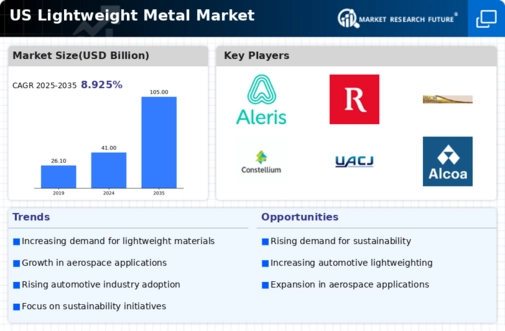The competitive insights of the US Lightweight Metal Market encompass a dynamic landscape characterized by a blend of established players and emerging innovators, each vying for market share in this rapidly evolving sector. Lightweight metals, predominantly aluminum and magnesium, have gained immense traction across various industries due to their superior strength-to-weight ratios, enhancing efficiency in applications, particularly in automotive, aerospace, and construction.
Companies operating in this market are continually seeking advancements in technology, sustainability initiatives, and strategic partnerships to differentiate themselves and maintain competitive advantages. The emphasis on lightweight solutions aligns with broader trends such as environmental awareness and fuel efficiency, driving market participants to innovate and improve their product offerings.
The competitive environment is also shaped by regulatory considerations, supply chain dynamics, and fluctuating raw material costs, making adaptability and innovation critical for staying relevant in this sector. Aleris stands out within the US Lightweight Metal Market with its strong focus on aluminum solutions that cater to a myriad of applications, particularly in the automotive industry.
The company has established a robust presence by leveraging its expertise in rolled and extruded aluminum products, which are crucial for manufacturers seeking lightweight solutions without compromising on strength and durability. Aleris' strategic initiatives, such as investments in advanced manufacturing technologies and a commitment to sustainability, bolster its competitive edge.
Additionally, their proactive approach to customer engagement and tailored solutions has positioned Aleris favorably in a market where customization and specific performance characteristics are highly valued. The company’s ability to respond rapidly to changing market demands and its strong partnerships within the supply chain further enhance its strengths in the US landscape.
Rio Tinto operates as a significant player in the US Lightweight Metal Market, focusing on supplying bauxite and aluminum, two key components for lightweight metal applications. The company’s vast resources allow it to maintain a stable supply chain while meeting the growing demand for aluminum across multiple sectors.
Rio Tinto's emphasis on innovation is reflected in its commitment to research and development, leading to the introduction of new and improved products that meet stringent industry standards. The company has also engaged in various mergers and acquisitions to expand its footprint and capabilities within the region, enhancing its competitive position.
Their integrated operations not only streamline production processes but also emphasize sustainability, targeting reductions in carbon emissions and promoting recycling initiatives. This strategic focus, combined with a comprehensive product portfolio that includes high-performance aluminum alloys, solidifies Rio Tinto's strength in the US Lightweight Metal Market, enabling it to respond effectively to both domestic and global market trends.

























Leave a Comment